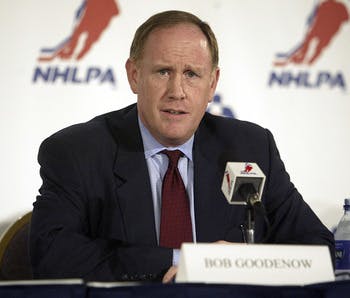The 1992 NHL Players’ Stike: A Relevant Story
By JP Nikota
11 years ago
I was only six years old when the NHL saw its first significant labour disruption in 1992, and to be honest, I had forgotten that it had happened at all. Having read Bruce Dowbiggin’s Money Players, however, the story seems suddenly relevant.
Full disclosure: I’ve taken nearly all my information from Dowbiggin’s book, so much credit goes to him for this article.
The NHL’s then-president John Ziegler was at the helm of a very prosperous league, and he was often seen publicly trumpeting the impressive financial gains achieved under his tenure. (Note: Sound like someone you’ve heard of?) The league was the beneficiary of franchise relocation and expansion fees, and a national broadcasting contract had been signed with SportsChannel in the U.S. Young stars Mario Lemieux in Pittsburgh and Wayne Gretzky in Los Angeles were growing the game south of the border in a big way. Disney’s The Mighty Ducks had just been released, and hockey was cool in the U.S.
The league was 50 games into what was then an 80-game season (it was later extended to 84 games) when recently-hired NHLPA boss Bob Goodenow called for job action. The players voted 560-4 in favour of a strike, and the league shut down for a mere 10 days. The players achieved increases in playoff bonuses, rights to their appearances on trading cards, and a few other issues.
Why did the NHL fold like Superman on laundry day? The answer is, in part, that there existed a disparity between smaller and larger-market teams. Minnesota North Stars GM Bobby Clarke said "It won’t be the poor owners who decide to give up, it’ll be the rich owners who want to get back to playing. They can still make money. The poor owners can stay out forever, because they have nothing to lose."
The Leafs, the Rangers, and the Habs and all the usual wealthy suspects were making money hand over fist and, since it was already April, many of the teams were hungry for playoff revenue. Many others, such as the Blues and the Sharks, were struggling to pay for brand new arenas, and attendance problems reared their heads in cities like Winnipeg and Hartford.
Even twenty years ago, smaller-market teams were having increasing difficulty signing high-profile players, as the era of multi-million dollar salaries had just begun (see: The Gretzky Trade). Players had recently started disclosing their salaries to each other so that they could compare their earnings to other players they perceived to be similarly talented. Moreover, with Alan Eagleson gone, players’ value was no longer being undercut.
Later, Eric Lindros’ long holdout for a contract lead to a massive contract (relative to the era) of over $3M a year, and set a benchmark for other young stars. If a man who hadn’t played a single NHL game could get this much money, what were all these other emerging stars worth?
The gap between the NHL’s poor and rich was already growing, but in the end, the wealthy teams and desperate new-arena teams forced the poorer ones to settle.
From Money Players:
Never underestimate how tough it was for Goodenow to sell the players on a strike," says former Calgary GM Craig Button. "He did a great job of getting the players that the owners couldn’t afford to stay out. But had management simply shut down the game for the rest of the year, we’d have destroyed his credibility. Once players saw what happened when Ziegler settled, the league guaranteed his credibility and made the 1994-95 lockout possible.
This was the NHL’s first big opportunity to address the disparity of riches amongst NHL teams, and they did nothing of the sort. No discussion of a hard cap. No mention of a luxury tax. No revenue sharing at all, actually.
So let’s recap
The NHL was, as a 22-team entity, a very healthy business, reaping record profits. Then, owners began to cry poor when players started demanding more money. Those teams that were struggling financially had their heads pushed back underwater so that the game could keep going, and no help was offered.
The current state of CBA negotiations between Donald Fehr and the NHLPA and Gary Bettman and the NHL is perhaps less different a problem than we realize: the league has been refusing to help out its poorer teams for decades, and has always tried instead to take the cash out of the players’ pockets.
Here is a good summary of today’s situation from Robert Boland the Tisch Institute at NYU via the CBC:
The functionality of this dispute really is about owner-to-owner [revenue sharing]. It’s that the big market teams are earning revenue at very, very high levels, the Original Six plus Philadelphia and maybe a couple of other very good franchises are doing really, almost record numbers, and some of the other franchises that are in more marginal markets are struggling more just to break even. So the fact that there is revenue growth, that drives the salary cap up, the salary floor up on all the teams, making it tighter on the smaller market teams. So one of the ways we would solve that problem is to share revenue between teams and manage that disparity, but that is very unpopular among owners, generally.
The circumstances around the issue have changed, but disparity between teams has been an issue for at least two decades now, and I’m willing to bet my hat that the wealthier teams get the season going again before the Winter Classic gets cancelled.
Recent articles from JP Nikota





